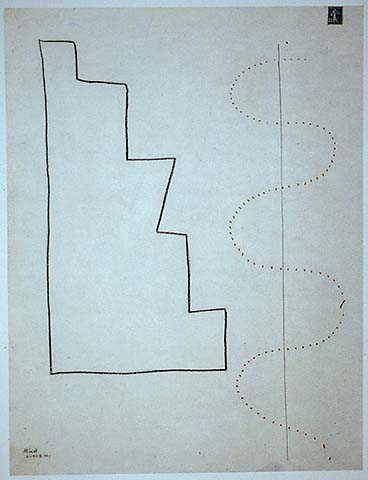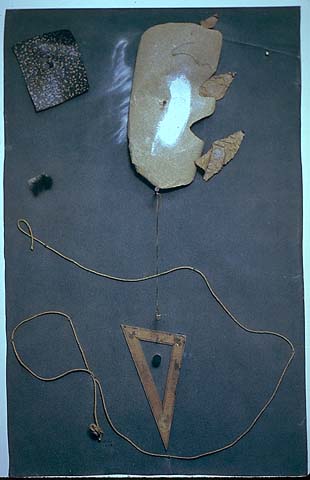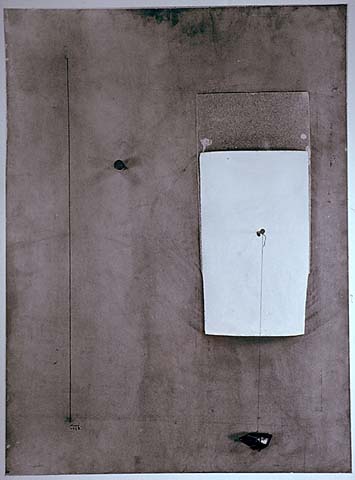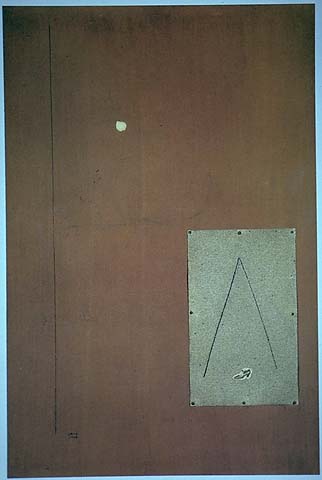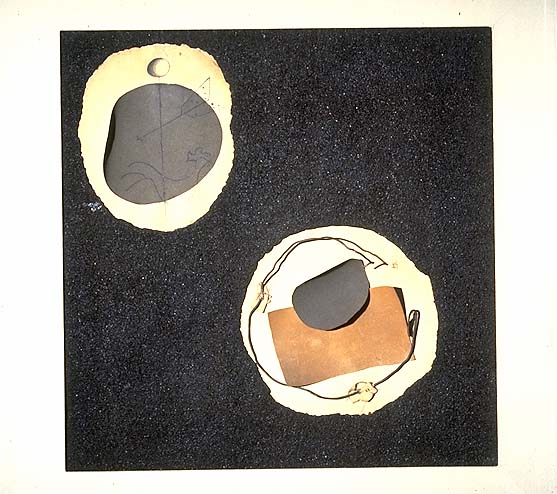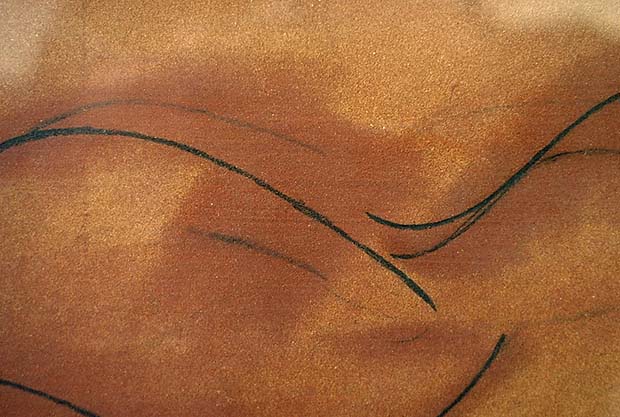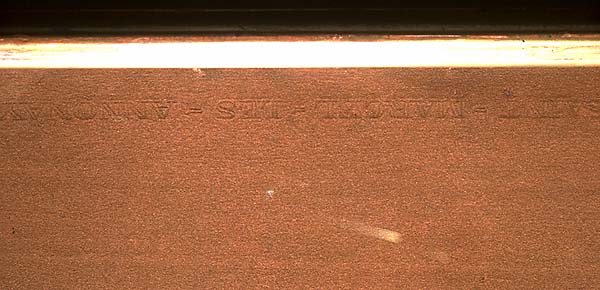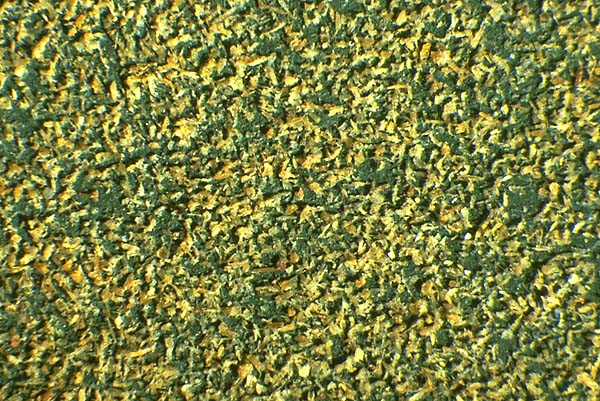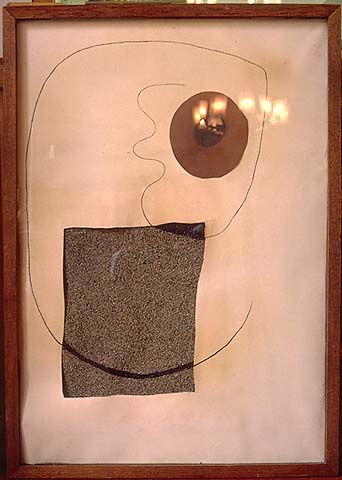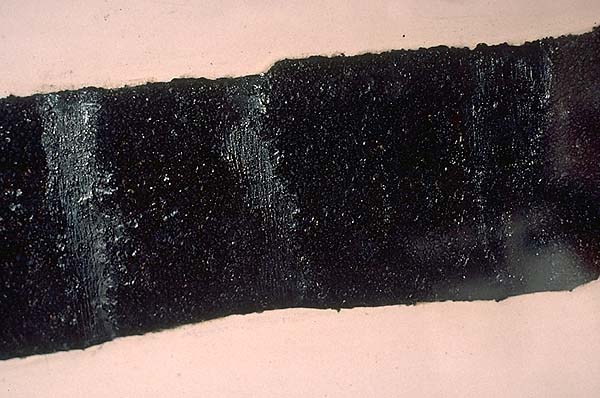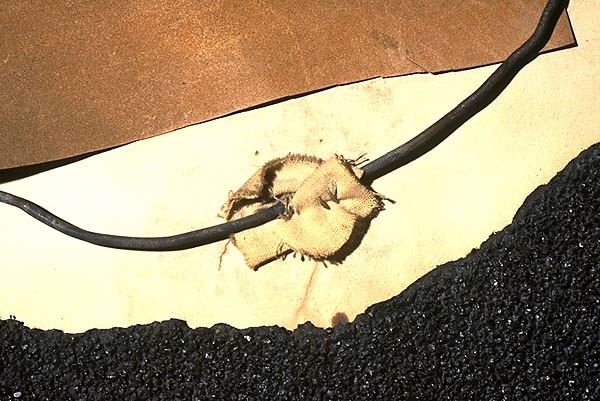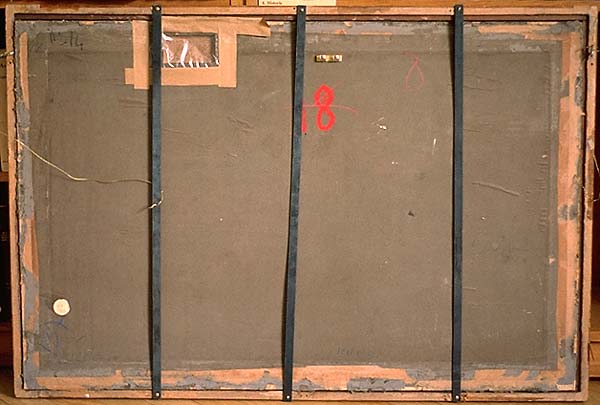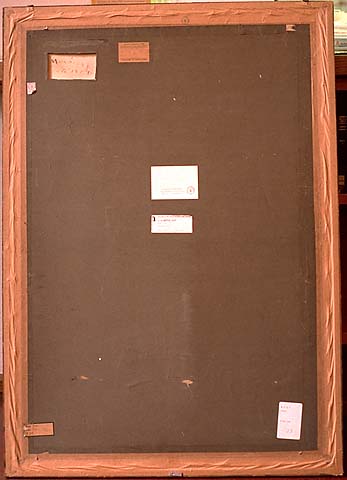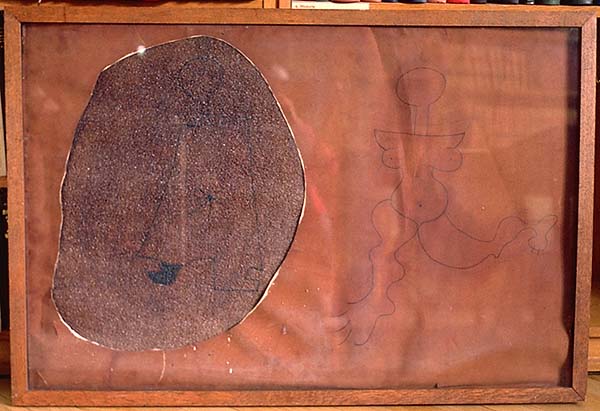A Technical Investigation of Joan Miró's Collages of the 1920s
by Erika Mosier and Anne UmlandIntroduction
This study of Joan Miró's collages of the 1920s, grew out of research initiated by Anne Umland in the early 1990s. The documentation of materials used and techniques employed by Miró in these collages is crucial to a more complete understanding of Miró's art and aesthetic. A piece-by-piece visual analysis of the papers employed by Miró enabled Anne and myself to discover some of the criteria that seemed to govern Miró's choice of materials which, in turn, sheds light on both the nature and pattern of his creative process.
Miró experimented with a wide variety of media and methods in the course of his artistic career - and his extraordinary sensitivity to surface and media is revealed to an unprecedented degree in his collages of the 1920s. The deliberate and informed choices of materials and characteristics of the papers utilized, with particular emphasis on tar paper, abrasive papers, and flocked papers which are commonly found in Miró's collages of 1928 and 1929, are a main focus of this study. The collages of the 1920s had never before been studied as a group. This presented an ideal opportunity for collaboration between the disciplines of art history and conservation.
Our research is based upon the extensive documentation that Anne and I gathered by first locating and then examining and photographing collages in both museums and private collections throughout the United States and Europe. This work resulted in a complete catalogue of Miró's collages of the 1920s prepared for the Fundació Joan Miró in Barcelona.
Overview Of Collage Production In The 1920s
Fig. 1. Graphite pencil on wove paper with printed text on verso; 4 1/4 x 3 3/8" (10.2 x 8.57 cm) [irregular]. Fundació Joan Miró, Barcelona (FJM 4345a). © 1996 Artists Rights Society (ARS), New York / ADAGP, Paris
Fig. 2. Untitled (Nude Descending a Staircase), Montroig, September 4, 1924. Conté crayon, crayon and graphite pencil on laid paper with a collaged postage stamp; 23 11/16 x 18 5/16" (60.17 x 46.51 cm). Private collection. © 1996 Artists Rights Society (ARS), New York / ADAGP, Paris
Miró executed three distinct groups of collages in the 1920s -- those of 1924, 1928, and 1929. Each year's work can be considered as a series that introduces new characteristics. Miró's collages are preceded almost without exception by at least one preliminary study that relates very closely to the finished work and in 1924 often specifies the type of collage elements to be used. The preparatory drawing (fig. 1) for a 1924 work with a collaged stamp (fig. 2) is inscribed at the upper left corner with the Spanish and French words for stamps; sellos and timbres. The X on this drawing is the mark that Miró used to indicate when a preparatory drawing was made into a finished work. Miró's five collages of 1924 are basically black and white drawings with one or two isolated collage elements. Areas of color are introduced with gouache, watercolor, and crayon. The collages seen are executed either on cream colored Ingres paper or on brown kraft paper.
Fig. 3. Spanish Dancer, [Paris, mid-February - spring] 1928. Chalk on grey fibrous flocked paper collaged with plaster [?] on sandpaper, three wrapping paper elements, twine, paint on string, thread, nails, tack, linoleum, wooden drafting triangle, hair woven in fabric, and cork mounted on five original [?] wood boards joined by two original [?] cross members; 41 3/4 x 26 5/8" (106.05 x 66.83 cm). The Morton G. Neumann Family Collection. © 1996 Artists Rights Society (ARS), New York / ADAGP, Paris
Fig. 4. Spanish Dancer (with Doll's Shoe), Paris, mid-February - spring 1928. Media on flocked paper collaged with paper, sandpaper, nail, string, doll's shoe and cork; 41 x 26 3/8" (104.14 x 66.99 cm). Location unknown. Photograph courtesy of Photographie Giraudon. © 1996 Artists Rights Society (ARS), New York / ADAGP, Paris
Fig. 5. "Danseuse Espagnole I" [Spanish Dancer I, [Paris, mid-February - spring] 1928. Conté crayon and graphite pencil on rust colored particulate flocked paper with paint on collaged sandpaper, collaged with printed element and nails; 40 1/2 x 28" (102.87 x 71.12 cm). Museo Nacional Reina Sofía, Madrid. © 1996 Artists Rights Society (ARS), New York / ADAGP, Paris
Fig. 6. Spanish Dancer (Portrait of a Dancer), Paris, mid-February - spring 1928. Canvas [?] collaged with cork, hatpin and feather; 39 3/8 x 31 1/2" (100.01 x 80.01 cm). Private collection. © 1996 Artists Rights Society (ARS), New York / ADAGP, Paris
In 1928 Miró introduces the use of flocked and abrasive papers. Three of the four collages are on flocked paper supports (figs. 3-5). The collages all have the same subject (figs. 3-6), a Spanish dancer, and three of the four are very spare compositions. A wide variety of collage elements are used in total for the series. Two of the "images" are created only with objects; no drawn lines are present. The other two images have only minimal drawing.
Fig. 7. Collage, Montroig, late July - early October 1929. Black pebble/tar paper with two cut-outs showing 1) conté crayon on laid paper collaged with grey fibrous flocked paper and 2) graphite pencil on laid paper collaged with brown particulate flocked paper, grey fibrous flocked paper, wire, fabric and string on an original [?] board; 27 x 27" (68.58 x 68.58 cm). Private collection. © 1996 Artists Rights Society (ARS), New York / ADAGP, Paris
Fig. 8. Collage, Montroig, late July - early October 1929. Conté crayon, gouache and ink on green particulate flocked paper with scraped areas, collaged with three wrapping paper elements, four wove paper elements, two rust colored particulate flocked paper elements, newspaper and abrasive cloth with a cut-out showing laid paper; 27 7/8 x 42 1/8" (70.80 x 107 cm). The Museum of Modern Art, New York. James Thrall Soby Fund (MoMA 1307.68). © 1996 Artists Rights Society (ARS), New York / ADAGP, Paris
In several of the 22 collages of 1929 Miró begins to cut-out areas in his primary supports revealing papers adhered to the verso perimeter of these apertures (fig. 7). Collaged elements curl and lift away from the surface. Miró uses tar paper for the first time in the 1929 collages, continuing his exploration into highly textured papers begun with the flocked papers in 1928. The flocked papers continue to be used in a number of collages from this period with the introduction of the scraping of their flocked surfaces (fig. 8). The structure of the 1929 collages is more complex with multiple layers requiring attachment to boards in some cases. Miró's drawn lines cross to different paper levels; from primary support to the papers seen through cut-outs and on collage elements. Miró makes lines three dimensional with his use of wire on two of the 1929 collages.
Papers
Whereas in 1924 the supports of Miró's collages were laid or wove sheets, in the collages of 1928 and 29 Miró most often used flocked papers or tar papers as primary supports along with abrasive papers and abrasive cloth, kraft paper, newspaper, and a thin glossy colored paper. Flocked and tar papers are the most frequently used paper types in the collages as a group. I would like to focus on these two types of paper. Miró did not, all things considered, use a wide variety of paper types. The flocked papers are the most prevalent papers in the 1928 and 1929 collages being found in 19 of the 26 collages. Miró is also known to have used these papers in at least 12 drawings of 1928 and 29.
Flocked paper is a paper coated with an adhesive and then, in Miró's case, dusted with a fine particulate or fibrous material. The flocked papers Miró used are most commonly referred to as pastel papers in the literature and art stores. These papers were usually employed for pastel work, since their abrasive surface would hold the pastel particles. Miró, however, uses them more as a drawing paper that introduces texture in the works of 1928 and 1929.
Fig. 9. Detail of Adultery, Paris, March 1928. Conté crayon and gouache on rust colored particulate flocked paper with scraped areas; 27 1/2 x 41 3/4" (69.85 x 106.05 cm). Museum am Ostwall Dortmund. © 1996 Artists Rights Society (ARS), New York / ADAGP, Paris
Unlike laid paper with its chain and laid lines, the surface of flocked paper has no inherent structure; this may have been one of the reasons it appealed to Miró. The extreme tactile quality of this flocked paper is not achieved in standard laid or wove papers. The fibers or particles grab and retain traces of pentimenti that are found in so many of his works (fig. 9). In many cases Miró scraped the fibers off the surface of the flocked papers revealing the colored, painted layer below. The colored flocked paper provides his often spare compositions with a sense of color and depth.
Fig. 10. Detail of"Danseuse Espagnole I" [Spanish Dancer I], [Paris, mid-February - spring] 1928. Conté crayon and graphite pencil on rust colored particulate flocked paper with paint on collaged sandpaper, collaged with printed element and nails; 40 1/2 x 28" (102.87 x 71.12 cm). Museo Nacional Reina Sofía, Madrid. © 1996 Artists Rights Society (ARS), New York / ADAGP, Paris
Fig. 11. Detail of"Danseuse Espagnole I" [Spanish Dancer I], [Paris, mid-February - spring] 1928. Conté crayon and graphite pencil on rust colored particulate flocked paper with paint on collaged sandpaper, collaged with printed element and nails; 40 1/2 x 28" (102.87 x 71.12 cm). Museo Nacional Reina Sofía, Madrid. © 1996 Artists Rights Society (ARS), New York / ADAGP, Paris
On eight out of the twelve fibrous and particulate flocked whole sheets the author has seen the pressmark: MONTGOLFIER SAINT-MARCEL-LES-ANNONAY (figs. 10 and 11) or an illegible pressmark. All of Miró's flocked papers are coated with a layer of colored paint (usually of a different color than the fibrous or particulate flocking) prior to the application of flocking. For example, on M.o.M.A.'s 1929 Collage the painted layer is green while the flocking layer is ocher colored (fig. 8). The paint, along with their type of flocking and pressmark, points to these flocked papers' use as a fine art material and not a utilitarian abrasive paper. There would be no reason to paint the base paper of a sandpaper or to use an art paper as a base sheet. The types of flocking on these papers would not stand up to any sanding use. Even though Miró's particulate flocked paper is visually similar to abrasive paper with its granular surface, it differs from abrasive paper in that it was used for fine art and was most likely not made by machine or in a mass produced fashion.
When Canson & Montgolfier who manufactured the base sheet was contacted they stated that they would not have applied any sort of flocked coating to their paper. Someone would have bought the pressmarked sheets and then coated them.
In conversations with me, Mr. Sennelier, of Sennelier's art supply store in Paris (where Miró could have obtained materials in the 1920s), stated there were workshops in the twenties making flocked art papers like Miró's. Mr. Sennelier visited a woman when he was young who made papers similar to the type Miró employed. He said that she supplied all of the art stores and was the last surviving person to produce flocked papers by hand. She used cork particles, sand, and cotton fibers on paper and sand on canvas. The woman produced the papers in green, grey, and cream colors. Mr. Sennelier remembered that she would coat the paper with glue, then put on the flocking, "in a cloud of dust"; "she was always covered with dust." She would shake the excess off the paper when dry. The coverage of the flocking was not very regular. Mr. Sennelier visited The Museum of Modern Art and saw several works by Miró on flocked papers. He did not seem to think that the woman he knew would have made any of the papers used by Miró that he saw at M.o.M.A., but that they were of a similar type. Mr. Sennelier said that M.o.M.A.'s works had a more even layer of flocking. This regularity is found in almost all of Miró's flocked papers.
The flocked papers Miró used in his 1928-29 collages and drawings may have indications of their maker on the verso as some of Miró's later works on flocked paper do. On 1933 and 1934 flocked paper works there are stamps printed in black reading PAPIER GRANEX / (DÉPOSE) / GRIS BRUN FONCÉ or VERDATRE with a picture of an anchor in a circle. On one work a similar anchor stamp with the words MARQUE DE FABRIQUE was also found. Since the authors were unable to see the versos of any of the works on flocked paper that were examined, we do not know if stamps were present.
Fig. 12. Photomicrograph of Collage, Montroig, late July - early October 1929. Conté crayon, gouache and ink on green particulate flocked paper with scraped areas, collaged with three wrapping paper elements, four wove paper elements, two rust colored particulate flocked paper elements, newspaper and abrasive cloth with a cut-out showing laid paper; 27 7/8 x 42 1/8" (70.80 x 107 cm). The Museum of Modern Art, New York. James Thrall Soby Fund (MoMA 1307.68). © 1996 Artists Rights Society (ARS), New York / ADAGP, Paris
Analysis preformed by Eugena Ordonez at The Museum of Modern Art on the choppy, light brown particulate flocking from M.o.M.A.'s 1929 Collage (fig. 12) revealed that the particulate is mainly cellulosic, consisting of soft and hardwood sawdust and a lot of pigment - zinc white in the lighter areas and possibly synthetic iron oxide in the browner areas. There may be a small amount of cork in the samples.
Fig. 13. Photomicrograph of Drawing-Collage, 1933. Conté crayon on green fibrous flocked paper collaged with sandpaper, postcards, and engravings; 42 1/2 x 28 3/8". The Museum of Modern Art. Kay Sage Tanguy Bequest. © 1996 Artists Rights Society (ARS), New York / ADAGP, Paris
All the fibrous flocked sheets examined by the author appear to be flocked with a mixture of white and black long fibers. With microscopic analysis it could be seen that there were very large clear fibers and smaller blackish ones (fig. 13). Microscopic analysis of the fibers' morphology preformed by Eugena Ordonez on a similar paper from a 1933 Drawing-Collage characterized the clear fibers as wool and the blackish fibers as wool dyed medium to dark blue. Infrared analysis confirmed that the fibers were proteinaceous. These are coated with a shiny substance, most likely the adhesive used to bind them to the support.
Fig. 14. Collage, Montroig, late July - early October 1929. Conté crayon on wove paper collaged with rust colored particulate flocked paper with a cut-out showing paint on natural pebble/tar paper mounted on an original [?] board in its original [?] frame; 40 3/4 x 28 1/4" (103.51 x 71.76 cm). Kunstmuseum Basel. Gift of Marguerite Arp-Hagenbach, 1968 (KK 1968.520). © 1996 Artists Rights Society (ARS), New York / ADAGP, Paris
Tar paper is the second most commonly used paper type in Miró's 1929 collages appearing in 11 of 22 works. Miró's tar paper is a material that consists of a thick layer of paper or a paper-like substance covered with tar with pebbles embedded in the tarry surface. In most cases Miró used a black sheet in which the pebbles are coated with a final layer of tar (fig. 7). He also used "natural" colored sheets (fig. 14) with no tar coating over the pebbles thus showing their original color. It seems that this tar paper was probably intended to be used as roofing or water-proofing and unlike his flocked paper was not intended for artistic use.
Manipulation of Materials vs. Damage and Wear
Miró often manipulated his materials in ways that to the untrained eye may appear as damages. Two types of intentional manipulations that can easily and have been mistaken for damages by non-conservators are removal of flocking and application of fixative.
Fig. 15. Detail of Collage, Montroig, late July - early October 1929. Conté crayon on wove paper collaged with black pebble/tar paper with scraped areas; 26 3/8 x 39 3/4" (66.99 x 100.97 cm). Collection Groupe Lhoist. © 1996 Artists Rights Society (ARS), New York / ADAGP, Paris
Miró has in some way removed, by rubbing or erasing, the flocking particles or fibers from a flocked surface (figs. 8 and 9) or the pebbles from tar paper (fig. 15). On flocked papers this removal is often found under the drawn lines and/or with traces of pentimenti, suggesting that Miró often slightly changed the position of elements while in the process of drawing.
In reference to fixing his works there is a page in one of Miró's notebooks which appears to list materials Miró needed (FJM 611b). This list was probably made sometime after August 1924. On one page he lists an aparell per fixar which translates to fixing device. The type of fixative and device he used it not known, though the fixative is very yellow and shiny like a natural resin, perhaps shellac.
Miró often brush fixes and spray fixes conté crayon which is not an extremely friable medium. Miró may have liked the saturation and gloss he achieved in brush fixing. In works that have been spray fixed a yellow halo is visible around areas of drawing which has been mistaken for paper degradation. There are cases of flocked drawings being spray fixed. Miró may have felt that the fibrous surface made the media susceptible to loss and he may have liked the resulting gloss in these cases also. Sometimes he just seems to saturate papers with fixative. Miró may have liked the yellow color and shiny surface the fixative gave him.
Construction
Fig. 16. Collage, Montroig, late July - early October 1929. Conté crayon on wove paper collaged with three grey fibrous flocked paper elements, one tan particulate flocked paper element, one rust colored particulate flocked paper element, black pebble/tar paper, wire and string; 30 5/16 x 21 7/16" (77 x 54.5 cm). Private collection. © 1996 Artists Rights Society (ARS), New York / ADAGP, Paris
In June 1968 in a conversation with William Rubin concerning M.o.M.A.'s 1929 collage, Miró said that the edges of the collage elements had always lifted away from the surface and they should never be flattened. This lifting can be seen in many of his collages either in their current state or in older photographs (figs. 7 and 16).
Often Miró's collages rather than simply employing pasted papers on a support introduce another layer of depth by cutting out an area of the primary support to reveal a paper applied to the verso perimeter of the removed area or seen through the removed area. The removed area in Miró's collages is circular or oval shaped in most instances. Two cut-outs are square or rectangular. The cut-outs are often jaggedly trimmed from the support. Many times these cut-outs have been identified as applied collage elements in the literature.
While most of Miró's collage elements are adhered to supports, his method of attachment of materials goes beyond just pasting of paper elements in several cases. In the Spanish dancer series of collages Miró uses nails to attach several elements. For one of the Spanish Dancer collages Miró uses square sided nails with circular heads to tack down the twine in various places (fig. 3). There are four very large nails in the sandpaper, the linoleum, and two anchoring the string. In another Spanish Dancer a doll's shoe is suspended from what appears to be a large round headed nail (fig. 4). In another Spanish Dancer eight round headed nails hold the edges of the sandpaper element to the support (figs. 5). It is interesting to note that this element is also adhered down to the support sheet along with being nailed.
Fig. 17. Detail of Collage, Montroig, late July - early October 1929. Black pebble/tar paper with two cut-outs showing 1) conté crayon on laid paper collaged with grey fibrous flocked paper and 2) graphite pencil on laid paper collaged with brown particulate flocked paper, grey fibrous flocked paper, wire, fabric and string on an original [?] board; 27 x 27" (68.58 x 68.58 cm). Private collection. © 1996 Artists Rights Society (ARS), New York / ADAGP, Paris
Wire is used in two collages to create line three dimensionally. The wire used in two 1929 collages appears visually similar (figs. 7 and 16). Miró places pieces of light colored fine woven cloth under and on top of the wire in one of the 1929 collages (fig. 17). He then sews through the fabric attaching the wire and the collage to the backing board. In the other collage with wire attached, the cloth is found on the verso of the support. This kind of complex structure often requires attachment to backing boards.
Backing And Framing
Fig. 18. Verso of Collage (Mercury; Surrealist Harmony), Montroig, late July - early October 1929. Graphite pencil and paint on rust colored particulate flocked paper with a cut-out showing paint on natural pebble/tar paper mounted on an original [?] board in its original [?] frame, 28 x 42" (71.12 x 106.68 cm). Ny Carlsberg Glyptotek, Copenhagen (I.N. 3175 R.W.). © 1996 Artists Rights Society (ARS), New York / ADAGP, Paris
Fig. 19. Verso of Collage, Montroig, late July - early October 1929. Conté crayon on wove paper collaged with rust colored particulate flocked paper with a cut-out showing paint on natural pebble/tar paper mounted on an original [?] board in its original [?] frame; 40 3/4 x 28 1/4" (103.51 x 71.76 cm). Kunstmuseum Basel. Gift of Marguerite Arp-Hagenbach, 1968 (K.K. 1968.520). © 1996 Artists Rights Society (ARS), New York / ADAGP, Paris
What is thought to be an original backing board was found on several of the examined works. The board is 1/4" thick, with a green-brown paper covering both sides. The backing boards have an area cut-out to reveal the signature (figs. 18 and 19).
The authors believe these backing boards are original because in these two 1929 collages the tar papers seen through the cut-outs are most likely attached to the board, making it almost impossible to separate the latter from the overall work. In one of the collages with wire, the wire attached to the surface of the collage is sewn through the backing board again making it difficult to detach one from the other.
Fig. 20. Collage (Mercury; Surrealist Harmony), Montroig, late July - early October 1929. Graphite pencil and paint on rust colored particulate flocked paper with a cut-out showing paint on natural pebble/tar paper mounted on an original [?] board in its original [?] frame; 28 x 42" (71.12 x 106.68 cm). Ny Carlsberg Glyptotek, Copenhagen (I.N. 3175 R.W.). © 1996 Artists Rights Society (ARS), New York / ADAGP, Paris
Both of the frames thought to be original on these works are band frames (flat face in the shape of an "L") of a similar size (figs. 14 and 20). From visual examination one appears to be made of mahogany, while the other seems to be stained pine; both are dark woods. The corners of the frames are mitered and are held with nails.
These two frames can be compared with that seen on M.o.M.A.'s 1929 Collage in its original state in a 1930 photograph. The frame in this photograph no longer exists, but the frames discussed are visually similar in style and therefore may be contemporary with it.
We have no written documents from the 1920s in which Miró comments on framing, but in a 1934 letter to Matisse he indicated a preference for simple frames:
As for the framing, the more simple and less elaborate it is, the more perfect and successful it will be. The walls of my studio are white-washed, and it is in this kind of atmosphere - of maximum serenity and simplicity - that I imagine my paintings, as far from Parisian refinement as possible. For the large exhibition at Georges Berheim's I had the very large paintings framed with a simple strip of natural wood, untouched even by a plane, which allowed the paintings to stand out and did not rob them in any way of their power and strength (translated in Rowell, Margit, ed. Joan Miró Selected Writings and Interviews. New York: Da Capo Press, 1986, p. 125).
Conclusion
The above statement makes apparent Miró's scrupulous attention to all aspects of the presentation of his works, a concern evidenced not only in the complex structures of his collages of the 1920s but extended to questions of display and framing. As the existence of the preparatory drawings which accompany the collages make clear, while Miró's collages especially those of 1928 and 29 often give the impression of having been roughly constructed or spontaneously assembled, they were exceptionally carefully planned from start to finish. Clearly the materials Miró used and the techniques he employed were essential to the realization of these plans.
Acknowledgements
This study was supported by a grant from the Fundació Joan Miró, Barcelona, funds from Marcia Riklis Hirschfeld and a Rousseau Fellowship from the Metropolitan Museum of Art, New York. Anne and I would like to thank everyone at M.o.M.A., especially Antoinette King and Carolyn Lanchner.
Erika MosierAssistant Paper Conservator
Yale Center for British Art
1080 Chapel Street
P.O. Box 208280
New Haven, CT 06520-8280 Anne Umland
Assistant Curator
Museum of Modern Art
Publication History
Received: Fall 1996
Paper delivered at the Book and Paper specialty group session, AIC 24th Annual Meeting, June 10-16, 1996, Norfolk Virginia.
Papers for the specialty group session are selected by committee, based on abstracts and there has been no further peer review. Papers are received by the compiler in the Fall following the meeting and the author is welcome to make revisions, minor or major.

